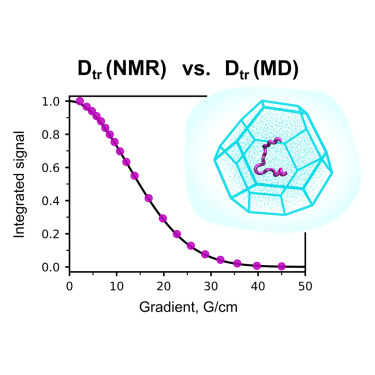
Olga O Lebedenko, Vladislav A Salikov, Sergei A Izmailov, Ivan S Podkorytov, Nikolai R Skrynnikov
https://www.sciencedirect.com/science/article/abs/pii/S0006349523007208
MD simulations can provide uniquely detailed models of intrinsically disordered proteins (IDPs). However, these models need careful experimental validation. The coefficient of translational diffusion Dtr, measurable by pulsed field gradient NMR, offers a potentially useful piece of experimental information related to the compactness of the IDP’s conformational ensemble. Here, we investigate, both experimentally and via the MD modeling, the translational diffusion of a 25-residue N-terminal fragment from histone H4 (N-H4). We found that the predicted values of Dtr, as obtained from mean-square displacement of the peptide in the MD simulations, are largely determined by the viscosity of the MD water (which has been reinvestigated as a part of our study). Beyond that, our analysis of the diffusion data indicates that MD simulations of N-H4 in the TIP4P-Ew water give rise to an overly compact conformational ensemble for this peptide. In contrast, TIP4P-D and OPC simulations produce the ensembles that are consistent with the experimental Dtr result. These observations are supported by the analyses of the 15N spin relaxation rates. We also tested a number of empirical methods to predict Dtr based on IDP’s coordinates extracted from the MD snapshots. In particular, we show that the popular approach involving the program HYDROPRO can produce misleading results. This happens because HYDROPRO is not intended to predict the diffusion properties of highly flexible biopolymers such as IDPs. Likewise, recent empirical schemes that exploit the relationship between the small-angle x-ray scattering-informed conformational ensembles of IDPs and the respective experimental Dtr values also prove to be problematic. In this sense, the first-principle calculations of Dtr from the MD simulations, such as demonstrated in this work, should provide a useful benchmark for future efforts in this area.
← PreviousТэги: Измайлов, Лебеденко, Подкорытов, Саликов, Скрынников
